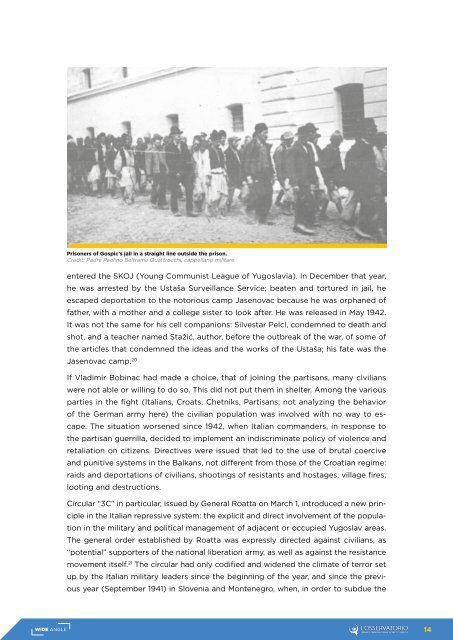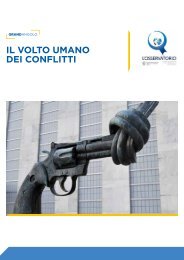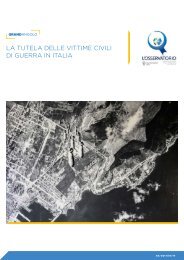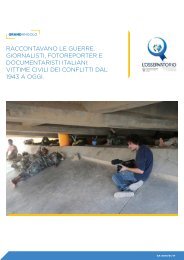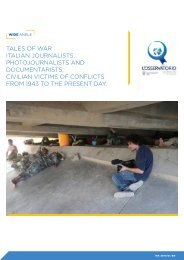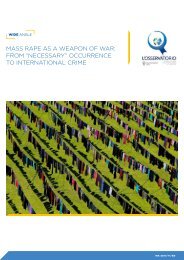The Horror in the Balkans. Civilian Victims in the Second World War in the Former Yugoslavia
Create successful ePaper yourself
Turn your PDF publications into a flip-book with our unique Google optimized e-Paper software.
Prisoners of Gospic’s jail <strong>in</strong> a straight l<strong>in</strong>e outside <strong>the</strong> prison.<br />
Credit: Padre Paol<strong>in</strong>o Beltrame Quattrocchi, cappellano militare.<br />
entered <strong>the</strong> SKOJ (Young Communist League of <strong>Yugoslavia</strong>). In December that year,<br />
he was arrested by <strong>the</strong> Ustaša Surveillance Service; beaten and tortured <strong>in</strong> jail, he<br />
escaped deportation to <strong>the</strong> notorious camp Jasenovac because he was orphaned of<br />
fa<strong>the</strong>r, with a mo<strong>the</strong>r and a college sister to look after. He was released <strong>in</strong> May 1942.<br />
It was not <strong>the</strong> same for his cell companions: Silvestar Pelcl, condemned to death and<br />
shot, and a teacher named Stažić, author, before <strong>the</strong> outbreak of <strong>the</strong> war, of some of<br />
<strong>the</strong> articles that condemned <strong>the</strong> ideas and <strong>the</strong> works of <strong>the</strong> Ustaša; his fate was <strong>the</strong><br />
Jasenovac camp. 20<br />
If Vladimir Bob<strong>in</strong>ac had made a choice, that of jo<strong>in</strong><strong>in</strong>g <strong>the</strong> partisans, many civilians<br />
were not able or will<strong>in</strong>g to do so. This did not put <strong>the</strong>m <strong>in</strong> shelter. Among <strong>the</strong> various<br />
parties <strong>in</strong> <strong>the</strong> fight (Italians, Croats, Chetniks, Partisans; not analyz<strong>in</strong>g <strong>the</strong> behavior<br />
of <strong>the</strong> German army here) <strong>the</strong> civilian population was <strong>in</strong>volved with no way to escape.<br />
<strong>The</strong> situation worsened s<strong>in</strong>ce 1942, when Italian commanders, <strong>in</strong> response to<br />
<strong>the</strong> partisan guerrilla, decided to implement an <strong>in</strong>discrim<strong>in</strong>ate policy of violence and<br />
retaliation on citizens. Directives were issued that led to <strong>the</strong> use of brutal coercive<br />
and punitive systems <strong>in</strong> <strong>the</strong> <strong>Balkans</strong>, not different from those of <strong>the</strong> Croatian regime:<br />
raids and deportations of civilians, shoot<strong>in</strong>gs of resistants and hostages, village fires,<br />
loot<strong>in</strong>g and destructions.<br />
Circular “3C” <strong>in</strong> particular, issued by General Roatta on March 1, <strong>in</strong>troduced a new pr<strong>in</strong>ciple<br />
<strong>in</strong> <strong>the</strong> Italian repressive system: <strong>the</strong> explicit and direct <strong>in</strong>volvement of <strong>the</strong> population<br />
<strong>in</strong> <strong>the</strong> military and political management of adjacent or occupied Yugoslav areas.<br />
<strong>The</strong> general order established by Roatta was expressly directed aga<strong>in</strong>st civilians, as<br />
“potential” supporters of <strong>the</strong> national liberation army, as well as aga<strong>in</strong>st <strong>the</strong> resistance<br />
movement itself. 21 <strong>The</strong> circular had only codified and widened <strong>the</strong> climate of terror set<br />
up by <strong>the</strong> Italian military leaders s<strong>in</strong>ce <strong>the</strong> beg<strong>in</strong>n<strong>in</strong>g of <strong>the</strong> year, and s<strong>in</strong>ce <strong>the</strong> previous<br />
year (September 1941) <strong>in</strong> Slovenia and Montenegro, when, <strong>in</strong> order to subdue <strong>the</strong><br />
14


